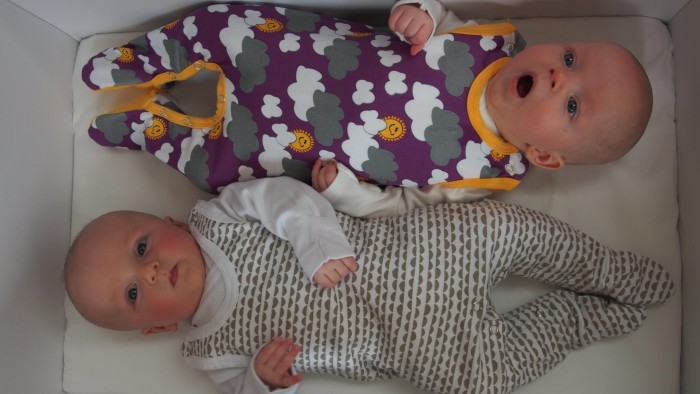Junior Isas — how to invest for your children

Roula Khalaf, Editor of the FT, selects her favourite stories in this weekly newsletter.
Junior Isas are a fantastic long-term, tax-free way of saving for your children’s future. Up to £4,080 can be paid in this year — rising to £4,128 in the new tax year from April 6 — yet most parents still opt to keep this in cash, rather than invest in shares or funds.
Of the £921m poured into Jisas in 2015-16, around 60 per cent was held in cash accounts — even though interest rates are at record lows.
As Jisas are long-term savings vehicles, your child’s savings have plenty of time to ride out the ups and downs of the stock market, and can compound away tax free if dividends are reinvested.
Money held within a Jisa is “locked up” until your child reaches the age of 18 — at which point, it converts to an adult Isa, and control of the account passes directly to them. This is a worry for some parents, who fear their careful efforts to save money will end with a teenage spending splurge. But with a new suite of Isa products designed for millennials — such as the Help to Buy Isa and new Lifetime Isa — there is every hope that they will keep up the savings habit.
Parents can easily start investing for their child via an investment platform, but will need to make some decisions about what investment strategy to take. Here, three writers tell us what approach they have adopted with children’s savings.
Claer Barrett, editor of FT Money
When my twin nephews Isaac and Joshua were born just over a year ago, my brother and sister-in-law’s lives changed beyond recognition. They would get one twin to sleep, then the other would wake up. They needed to buy two of everything. And the nappies! So when I offered to step in and sort out their Junior Isas, they said go for it.
“What’s the best interest rate?” my brother asked. “Tsk!” I replied. You don’t want to hold an 18-year investment in cash. Stocks and shares are a better bet. “Don’t we need thousands of pounds to open an account?” his wife asked. No. This is a common misconception — people think you have to be loaded to be an investor. In fact, with a regular savings plan, you can invest as little as £10 a month per child on some online platforms.
Setting up such a plan was particularly pertinent for our family. Twins wreck your finances. Other than a few hundred pounds per child to get them started, the new parents did not have much more to contribute. Only parents can open a Jisa for their child — but anyone can pay into one, providing they have the account details, and collectively no more than the annual limit is paid in. As a proud auntie, I was happy to set up a regular monthly payment of £50 per twin (they get enough actual presents at Christmas and birthdays — I’m guessing that having some money to play with when they turn 18 will be more valuable).

Some of their godparents and grandparents were also keen to contribute. This form-filling creates a bit of administration for the parents who control the accounts. Some platforms set minimum investments per month for different funds. Some allow multiple direct debits, some only allow one. The main account holder has to specify how the money is invested. And so long as gifts come from your regular income (rather than a transfer of capital) inheritance tax won’t be an issue.
While we were unlikely to hit the annual limit, I was keen to pay as little as possible in fees and charges. So as well as researching low cost funds, I also sought out the lowest cost platform for our needs (assuming that we would invest about £1,500 a year per child).
Most platforms have an annual charge, typically calculated as a small percentage of the assets invested within the Jisa. If parents already hold investments themselves, start with your own platform — some, such as TD Direct, offer a Junior Isa for ‘free’ if you’re already paying for your own trading account (though you will still pay 0.3 per cent a year on Jisa money invested in funds).
And some platforms have a minimum annual charge (such as Fidelity where the flat-rate service fee for a Jisa is £25, replaced by a 0.35 per cent charge when you have over £7,500).
As I was opening two Jisas, for two children born on the same day, a thought crossed my mind. Should we just open one Jisa account, thus only paying one annual fee? We’d have to trust that Joshua would give Isaac half of the pot when they turned 18 — but would he run off to Las Vegas and leave his twin brother weeping? (Knowing Joshua as I do, this is a risk. He is the most adventurous of the pair, was the first to start crawling, and is drawn to objects that he knows he is not allowed to touch.)
After researching all of the major investment platforms, we plumped for Bestinvest. You don’t need an adult Isa account, there is no minimum fee, and the annual charge is a low 0.4 per cent of your investment, accrued on a daily basis (so around £5 per child for the first years’ balance of £1,500). There are no transaction fees for buying funds, meaning this suited a regular savings plan (your own needs may be different — there’s no substitute for doing your own research).
Next, I thought about investment strategy. I toyed with the idea of conducting an 18-year experiment to see whether a passive or active approach would return the most. Danger-loving Joshua would get emerging markets, biotech stocks and technology funds (these are “high risk, high potential reward” — but many have high fees to match). Whereas angelic Isaac, whose favourite thing is to sit on mummy’s knee and say “moo” to his farmyard book, would get a cheap but unexciting global index tracker. This would hopefully compound away gradually, with no high fees to eat into his returns.
A dual strategy approach would have made a great column in 18 years’ time — although the poorer twin may have disowned me. But I am unlikely to be FT Money editor in the year 2035. This got me thinking about ageing fund managers. Would the household names of today still be doing their thing nearly two decades hence? Going down the active route would mean we’d have to review the twins’ Jisas more regularly.
All things considered, we got started with a global index tracker. I chose one from the Vanguard LifeStrategy range, which I also hold within my own stocks and shares Isa. The asset allocation is managed for you, as it consists of 14 underlying Vanguard trackers (you can vary the weighting of equities to bonds) covering both the developed world and emerging markets. Sure, the returns won’t shoot the lights out, but the ongoing charge is low at 0.22 per cent.
Similar “all in one” products are available from BlackRock (look for its Consensus range), plus L&G offers Multi-Index funds, and Standard Life has a range called MyFolio. The fees on such products are low, but will rise if any element of active asset allocation is involved. Now, where did I put that farmyard book?

Holly Mackay, founder and chief executive of Boring Money
Like many parents I want to help my kids to understand money. Where it comes from. How you manage it. And what the world of commerce looks like. I have two Junior stocks and shares Isas for my children, who are aged 9 and 6. This year, I am going to let them help manage their investments.
This might sound nuts, but I am hoping that getting to talk about ‘”grown up” things like money will appeal to them. How businesses make money, what ideas new tech start-ups are coming up with and the benefits of investing in different countries around the world are all subjects I’m confident that they can grasp on some level — and hopefully, this will spark their interest further.
I have already picked funds for their Junior Isas which have a very long-term focus. And they are risky. Investing for kids is so counter-intuitive — a baby has the greatest tolerance for risk out of any of us as they have 18 years to ride out the ups and downs of any Junior Isa. Over the past year, their Junior Isas have not done as well as other investment portfolios I have myself, as theirs are heavily overweight in early-stage companies and emerging markets.
My kids are both in Neil Woodford’s Patient Capital Trust, which I see as a long-term Dragons’ Den type of play. It is in the red this year, but I’m not worried — we have at least 10 years up our sleeves. Across his whole portfolio, my son has a spicy 28 per cent allocation to the emerging Asia region, compared with my daughter’s 20 per cent. Her greater exposure to the UK and the US has benefited her in the past year.
As I have added money for them at different times, they are in different funds. In 2016, after fees, my son only made a return of 4.8 per cent compared to his sister’s 7.7 per cent. Cue Mum guilt. I’m sure he won’t be happy to learn this fact. So the thought struck me — could sibling rivalry be the answer to getting kids engaged in “boring” old finance?
Isa Guide 2017
FT Money

Isas: still the best investment after nearly 20 years
What every parent needs to know about the Lifetime Isa
Where can I get the new Lifetime Isa?
How will the new Lifetime Isa work?
The best and worst rates on cash Isas
Investors play the waiting game for Innovative Finance Isas
Is the Lisa a stalking horse for pension reforms?
Independents add so much value to your portfolio
Podcast: FT Money Show Isa special
As I run my own business, my children already have a very basic understanding of how businesses make money. They were also quite interested about Brexit and the election of Donald Trump (who my son really dislikes because “he is rude to ladies”).
Given market fundamentals, I have been explaining the populist line that US stock markets are in for a good 2017 (though the children may veto that on anti-Trump grounds).
I will also let my son decide whether to add the Lindsell Train Global Equity fund which my daughter holds to his portfolio (the absence of that hurt him in 2016) or to stick with his Jupiter Asia, Lindsell Train UK Equity and Stewart Investors Asia Pacific Leaders funds. Will emerging markets reward investors over the next 10 years? And will my children be able to resist the temptation to try and switch funds too often, or attempt to time markets?
He’s got his six-year-old sister to beat — frankly, I can’t see any bigger carrot. Maybe we should report back next year on how two primary school kids did against the industry’s asset allocation experts. Whatever happens, I hope that by teaching them the investment basics, they will want to keep investing in a fully-fledged stocks and shares Isa by the time their Jisas come of age on their 18th birthdays. And not disappear to a beach in Thailand.
Maike Currie, FT Money’s Income Investor columnist and investment director at Fidelity International
For me, 2016 was a memorable year — not because of Brexit and Trump, but because of the birth of my baby daughter Elise. Against a backdrop of uncertain times, my top financial resolution for 2017 was to invest for her. I have adopted a “lock up and go” approach with her Junior stocks and shares Isa. Any “bonus” money will be locked up here until she reaches the age of 18 (I can pay in just over £4,000 per tax year). It’s also a good place to direct friends and grandparents when they ask “What can I get Elise for Christmas?”
For this “set and forget” fund, a low-cost, low-maintenance investment such as a global exchange traded fund or tracker makes sense. With the Isa allowance for adults set to increase to £20,000 when the new tax year begins in April, the “go” part of my strategy will be to dedicate a slice of my own enlarged annual Isa allowance towards saving for her future. By setting up a regular savings plan this will be a more disciplined way of putting money aside each month. And unlike the Jisa, where money cannot be withdrawn until her 18th birthday, it has the added benefit of ready access should I unexpectedly need the money.
With a time horizon of at least 18 years, my daughter can afford more risk with her investments than me. And, if her savings are to enjoy any decent growth in a world of paltry returns, the stock market is the only answer. It is very important to me to teach her about money and investing and there is no better way than via equities. Unlike cash, companies come with stories — so from time to time, the Hungry Caterpillar will need to make way for the tales behind the companies inside her investment portfolio.
Comments